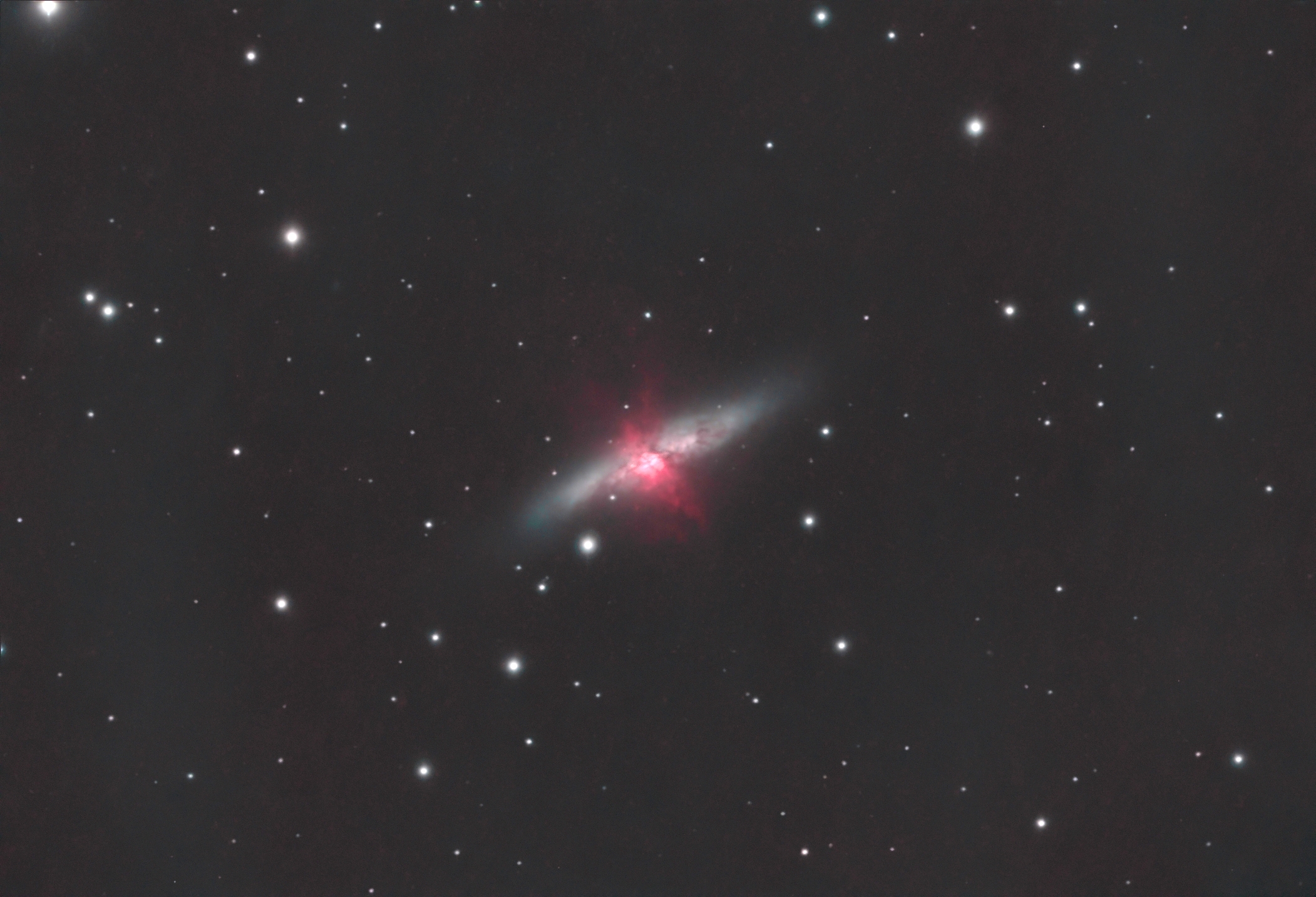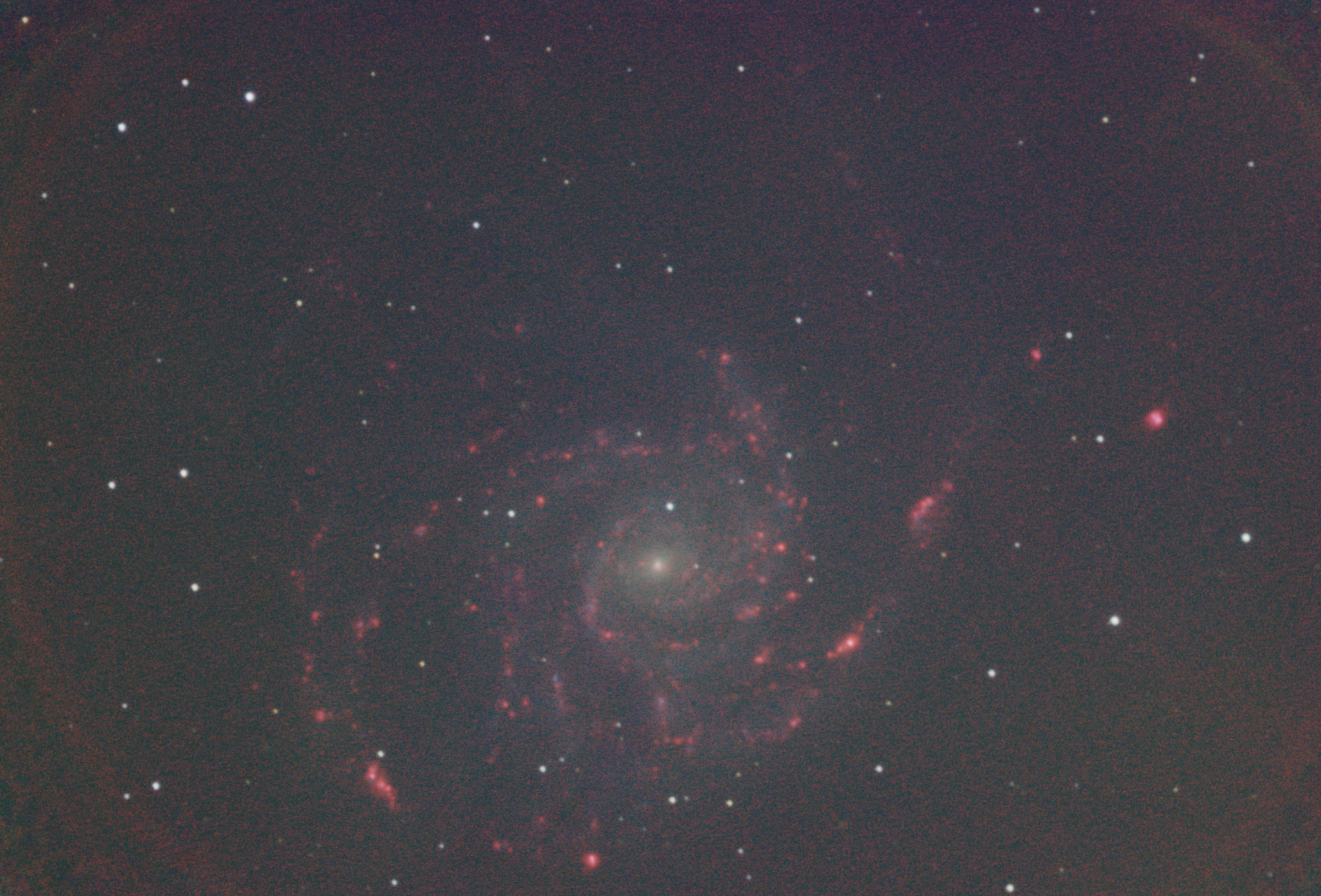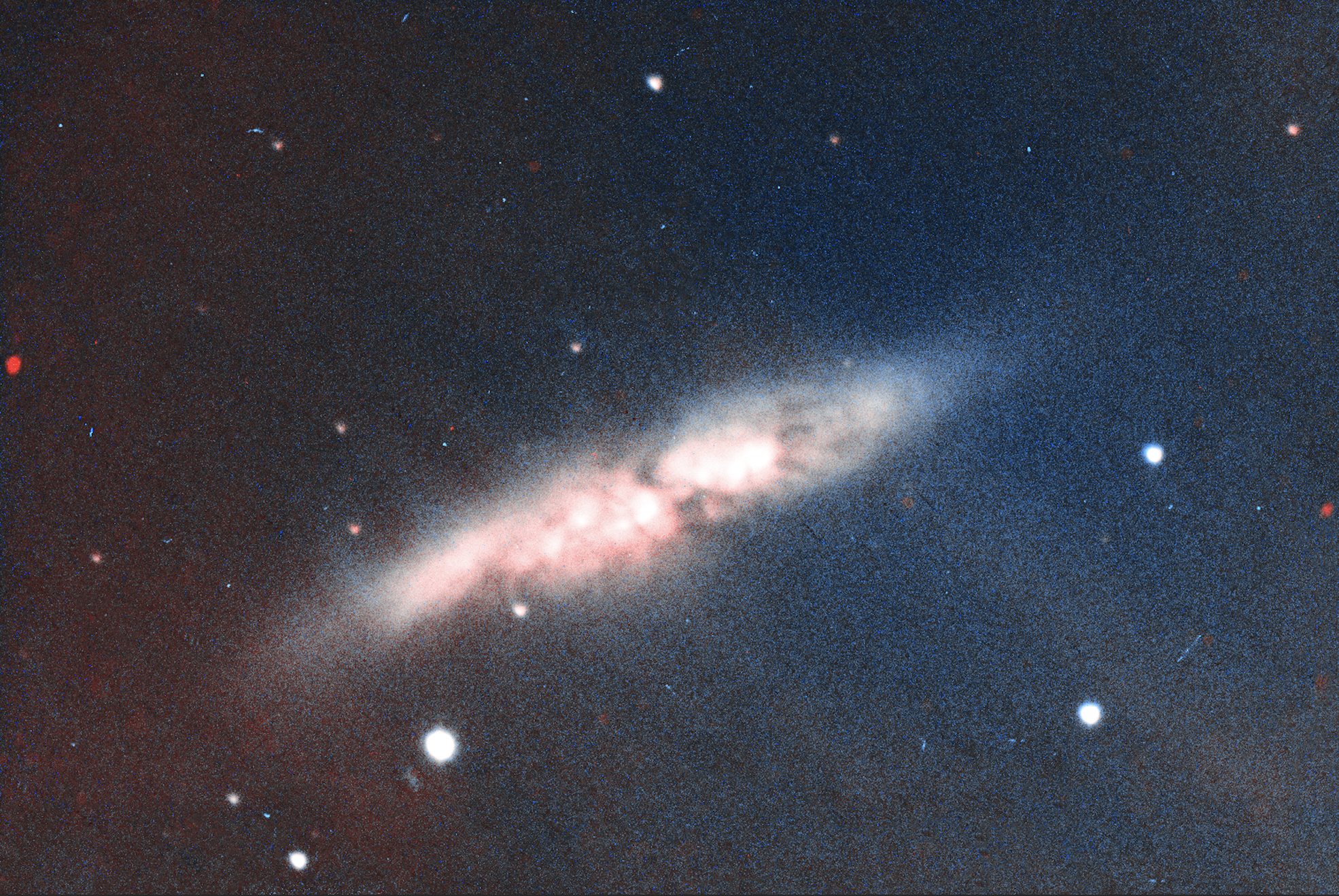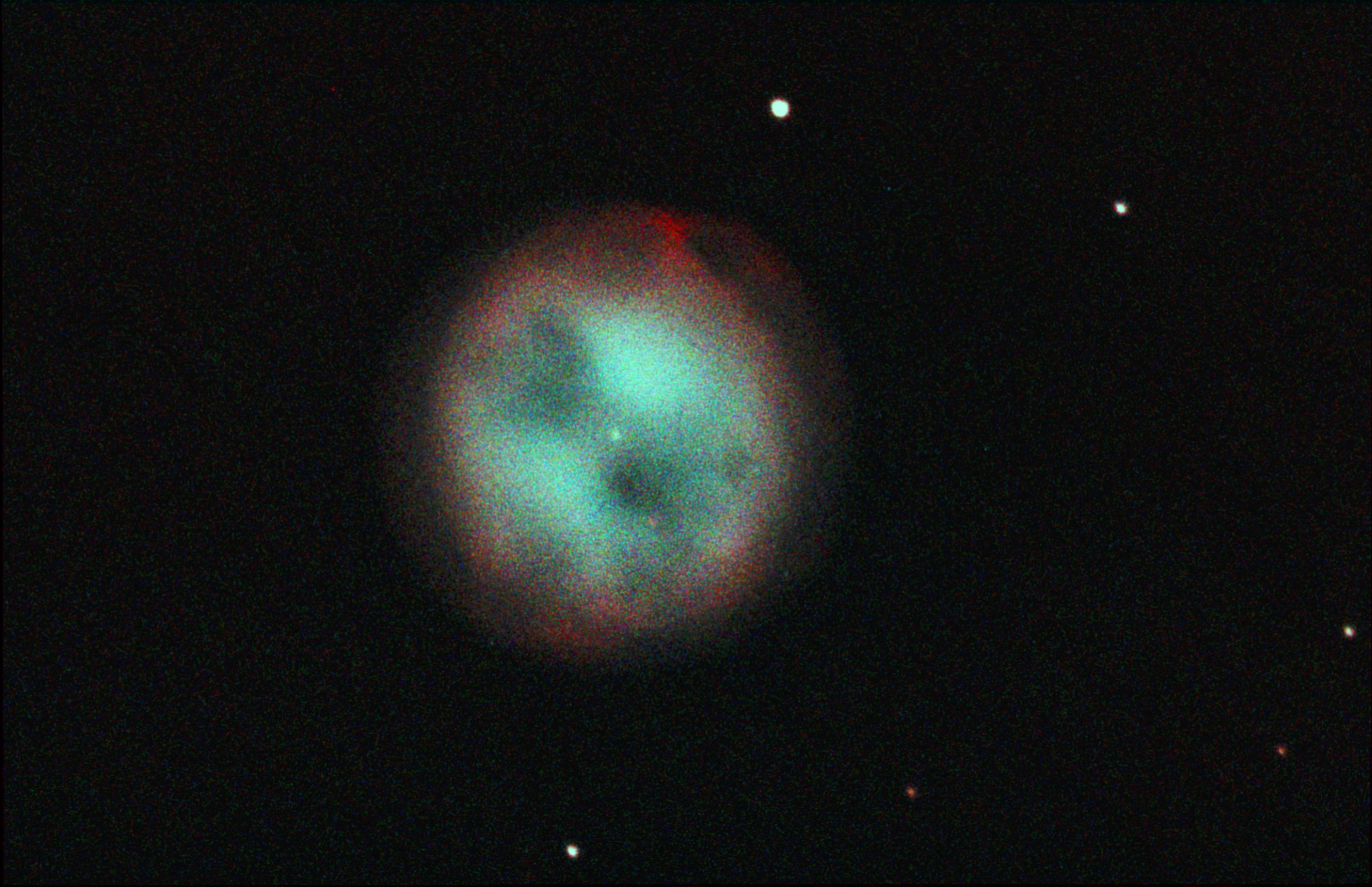ASTR 288T Spring 2025
The UMD Astronomy Observatory Remains Closed
Fall 2025 Update: The UMD Astronomy Observatory remains closed to all public outreach activities.
ASTR 288T Introduction to Astrophotography is the Astronomy Department's first Student Initiated Course (STICs) and was offered in Spring 2025. This first cohort was taught by senior Chaitanya Garg and sophomore Matthew Prem. Below are the results of the team projects:
Messier 82: Starburst Galaxy in the North

Telescope: 178mm (aka 7") f/9 Astro-Physics refractor
Camera: ST-10XME cooled monochrome CCD
FOV: 29.9' x 20.4'
Data:
20x180s = 1h Hα
20x180s = 1h Sloan g'
Total exposure = 2 hours
Software: Siril (calibration, registration, stacking, color compositing, and stretching), Pleiades Astrophoto PixInsight (plugins), BlurXTerminator (sharpening), and NoiseXTerminator (noise reduction)
Image credit: Paul Voelker, Joseph Bailor, Kurt Kovacs, and Harkeerat Singh
Description: Have you ever seen a galaxy explode? In this incredible image by ASTR 288T students, you can see the glow of ionized hydrogen gas as it is driven out of the galaxy by the aftermath of a recent episode of intense star formation. Created using the UMD observatory's 7" refractor with an hour of exposure time through a Hydrogen-alpha filter, an optical filter designed to let through a single, specific color of light emitted by ionized Hydrogen; and an additional hour of exposure time through a Sloan-g' filter to capture the bluish light emitted by young stars, the image showcases the dynamic nature of this "island universe" as we look at it, 10 million light years further than the stars in the image that reside comfortably within our own galaxy. To go from the monochrome images recorded by the camera to the full-color image you see here, the red, green, and blue color channels in the image were filled in with data from the filters, with the red channel filled with the H-alpha data and the green channel filled with the Sloan-g' data. Since only two filters were used when gathering the data for this image, this group opted to set the blue channel as the average of the H-alpha and g' images. These color channels were then adjusted using Siril's color calibration tool to approximate a natural color image. After stretching the image to reveal the galaxy from the background sky, noise reduction using NoiseXTerminator, and sharpening with BlurXTerminator, Messier 82 (M82) isn't the only galaxy visible. If you have sharp eyes, you might be able to spot LEDA 2732102 in the upper left, lying roughly 150 million light years beyond even M82.
Messier 101: A Trillion-Star Pinwheel

Telescope: 178mm (aka 7") f/9 Astro-Physics refractor Camera: ST-10XME cooled monochrome CCD FOV: 29.3' x 19.8'
Data:
20x60s + 10x300s = 1.17h Sloan g'
20x60s + 10x300s = 1.17h Sloan r'
40x60s + 10x300s = 1.5h Hα
Total exposure = 3.83 hours
Software: Siril (calibration, registration, stacking, color compositing, and stretching), GNU Image Manipulation Program (manual dust spot removal)
Image credit: Sriya Peddinti, Emma Bluestein, Lasya Muthyam, Helia Eshaghi
Special thanks: Matthew Prem
Description: Is that a pinwheel you would place in your yard to spin in the wind? Only if your yard is 200,000 light-years across! Messier 101, also known as the pinwheel galaxy, is one of the finest examples of a spiral galaxy, with its disk oriented face-on towards us. Previous interactions with other nearby galaxies have led to a clearly defined spiral structure, easily seen through the broadband Soan r' and Sloan g' filters, speckled with star-forming regions that glow brightly when viewed through an H-alpha filter. H-alpha, appearing as a deep red to human eyes, was assigned to the image's red channel, followed by the Sloan r' data in the green channel and the Sloan g' data in the blue channel. Unfortunately, frost on the image sensor has resulted in artifacts near the image's corners. Dust movement between the capture of the image and the capture of flat frames to calibrate out the impacts of dust in the optical path meant that dark spots in the images remained and had to be manually removed using GIMP before final image processing. Despite the significant detail shown in this image, there is a noticeable amount of noise, especially in the red channel. This simply means that the image would benefit from the inclusion of a longer total integration time due to Messier 101's low surface brightness.
Messier 82: A Dusty Cigar

Telescope: 14" f/11 SCT (Celestron C14) Camera: ST-8XME cooled monochrome CCD FOV: 12.1' x 8.1'
Data:
16x300s = 1.3h Sloan g'
16x300s = 1.3h Sloan r'
Total exposure = 2.6 hours
Software: Siril (calibration, registration, stacking, color compositing, and stretching), Adobe Photoshop (manual dust spot removal)
Image credit: Mackenzie Samartzis, Sofia Merchant-Dest, Jorge Argueta, Oliver O'Brien
Description: Messier 82, colloquially known as the cigar galaxy, is one of the best galaxies to observe during the Northern Hemisphere spring. While technically a spiral galaxy, we see it nearly edge-on, so it appears more like an oval or a cigar. In contrast to the other image of M82 featured here, this group opted for a closer view of the galaxy, using only broadband filters to emphasize the dust lanes within the galaxy over the ionized gas emanating from it. Despite the use of calibration frames, several artifacts from dust in the equipment persisted through the stacking process. These had to be manually corrected using an additional image processing software, Adobe Photoshop, in this case. This image, along with the other image of M82 taken this year, is an example of how atmospheric conditions impact how sharp deep-sky images can be. While larger telescopes have a better theoretical resolution than smaller telescopes, the motion of the atmosphere blurs images more than the theoretical limits of both telescopes used. This means that when you overlay the two images and adjust for the scaling, the disks of the stars are essentially the same size!
Messier 97: A Ghostly Owl

Telescope: 14" f/11 SCT (Celestron C14)
Camera: ST-8XME cooled monochrome CCD
FOV: 12.1' x 8.1'
Data:
10x300s = 0.83h Hα
10x300s = 0.83h [O III]
Total exposure = 2.8 hours
Software: Siril
Image credit: Enora Mech, Reese Williams, and Sarah Blaufuss
Description: Did a colorful owl fly in front of our telescope? No, a star died! This avian pareidolia is of a planetary nebula, a type of emission nebula that forms when a star roughly the mass of our sun dies. The remnant of the star that produced this nebula, known as WD 1111+552, is an object known as a white dwarf. The high-energy ultraviolet light coming from this object provides the energy needed to cause the gases in the planetary nebula to fluoresce. These fluorescent emissions happen at very specific colors and can be captured using narrowband filters. For this image, red light from Hydrogen and cyan light from Oxygen were captured using a monochrome camera and then digitally combined into this full-color image. The speckles you see in this image are simply a result of the limited exposure time and would disappear if we had been able to collect images of this object for closer to 10 hours.